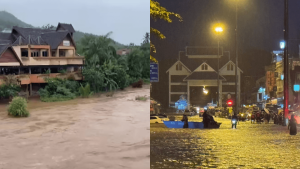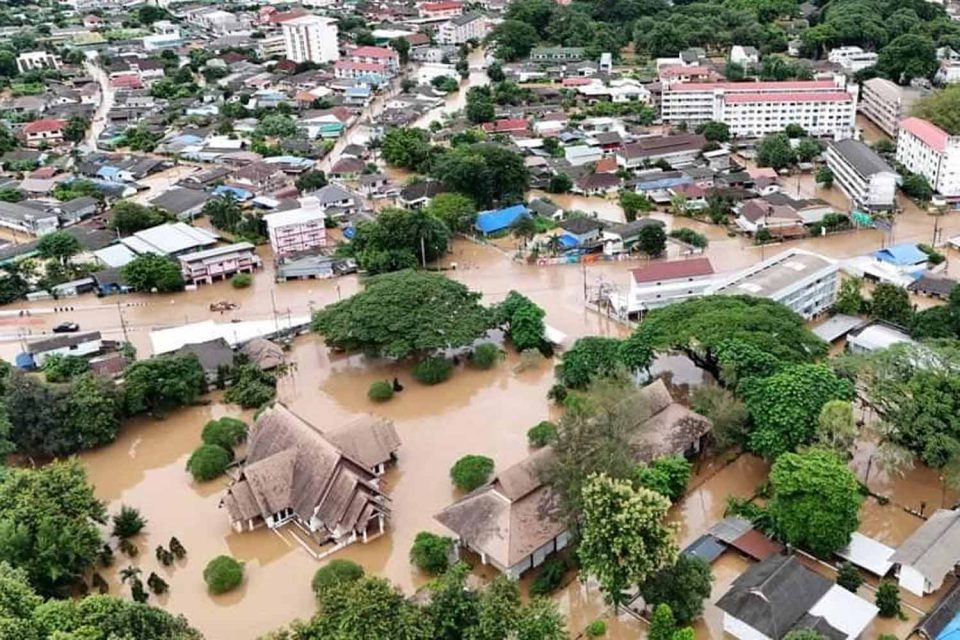The economic center of Thailand’s northernmost province is now submerged, with floodwaters reaching waist-deep levels and continuing to rise due to the overflowing Kok River.
On Thursday, flooding caused the closure of Mae Fah Luang Chiang Rai International Airport, with the last Thai AirAsia flight departing at 1:10 pm.
Authorities announced the closure of roads and bridges in Muang district, disrupting access to key areas, including the airport, the five-way Pho Khun intersection, and the provincial hall.
Evacuations began on Wednesday night as residents could no longer stay in ground-floor homes due to strong currents. Jet skis were deployed to assist in rescuing those trapped by the fast-flowing waters.
Chiangrai Prachanukroh Hospital in Muang district announced it was only treating emergency cases on Thursday.
Muang district is one of six districts impacted by floods in Chiang Rai, along with Chiang Khong, Chiang Saen, Mae Chan, Mae Fah Luang, and Mae Sai.
Over 10,000 households have been affected, and three deaths have been reported in Mae Fah Luang. However, the Sai River in Mae Sai district showed signs of improvement, with water levels dropping and Phahon Yothin Road returning to normal conditions on Thursday.
Despite the improvement in Mae Sai, conditions in downtown Muang district remained severe. The Mae Sai border checkpoint remained closed for vehicles traveling to Myanmar, as flood damage required cleanup before reopening. Thai officials were coordinating with Myanmar immigration officers to facilitate the return of stranded Myanmar nationals.
Vendors at the Sai Lom Joy market, located along the border, began cleaning up damage on Thursday morning. Residents were also able to access the previously unreachable Koh Sai community, though some areas were still submerged.
Navy officers, police, rescue workers, and municipal officials from tambon Mae Sai continued evacuating residents stranded in their homes for more than two days. Marine police deployed flat-bottomed boats from three stations to assist, with officers wading through water to reach victims, particularly the elderly, women, and children in areas boats couldn’t access.
In Muang district, rescue teams worked to evacuate victims after the Kok River burst its banks, flooding many downtown areas. Water levels at the Phor Khun intersection rose to around 30 centimeters.
Suttipong Juljarern, the permanent secretary for the Interior Ministry, said several previously flooded roads were now passable after the Sai River’s water level dropped by about a meter.
 40 Provinces on Alert
40 Provinces on Alert
The Office of National Water Resources reported on Thursday that over 40 provinces remain on high alert for possible flash floods, with a new tropical depression expected to intensify by September 18.
Since Tuesday, floods in northern provinces Chiang Rai and Chiang Mai have claimed the lives of at least nine people, according to government sources.
The Meteorological Department warned that more heavy rain is expected nationwide from Friday through early next week.
Since August 16, floods and landslides have caused the deaths of 33 people across Thailand and affected nearly 110,000 households, according to the Department of Disaster Prevention and Mitigation.
Typhoon Yagi, the strongest storm to hit Asia this year, has impacted around 34,000 households in northern Thailand. The storm has also devastated neighboring Vietnam, where it has left at least 157 dead and 139 missing.




